HOTSPOT
-
You have an app that generates 50,000 events daily.
You plan to stream the events to an Azure event hub and use Event Hubs Capture to implement cold path processing of the events. The output of Event Hubs Capture will be consumed by a reporting system.
You need to identify which type of Azure storage must be provisioned to support Event Hubs Capture, and which inbound data format the reporting system must support.
What should you identify? To answer, select the appropriate options in the answer area.
NOTE: Each correct selection is worth one point.
Answer:

You have SQL Server on an Azure virtual machine. The databases are written to nightly as part of a batch process.
You need to recommend a disaster recovery solution for the data. The solution must meet the following requirements:
✑ Provide the ability to recover in the event of a regional outage.
✑ Support a recovery time objective (RTO) of 15 minutes.
✑ Support a recovery point objective (RPO) of 24 hours.
✑ Support automated recovery.
✑ Minimize costs.
What should you include in the recommendation?
Answer:
D
Replication with Azure Site Recover:
✑ RTO is typically less than 15 minutes.
✑ RPO: One hour for application consistency and five minutes for crash consistency.
Incorrect Answers:
B: Too slow.
C: Always On availability group RPO: Because replication to the secondary replica is asynchronous, there's some data loss.
Reference:
https://docs.microsoft.com/en-us/azure/site-recovery/site-recovery-sql
HOTSPOT -
You plan to deploy the backup policy shown in the following exhibit.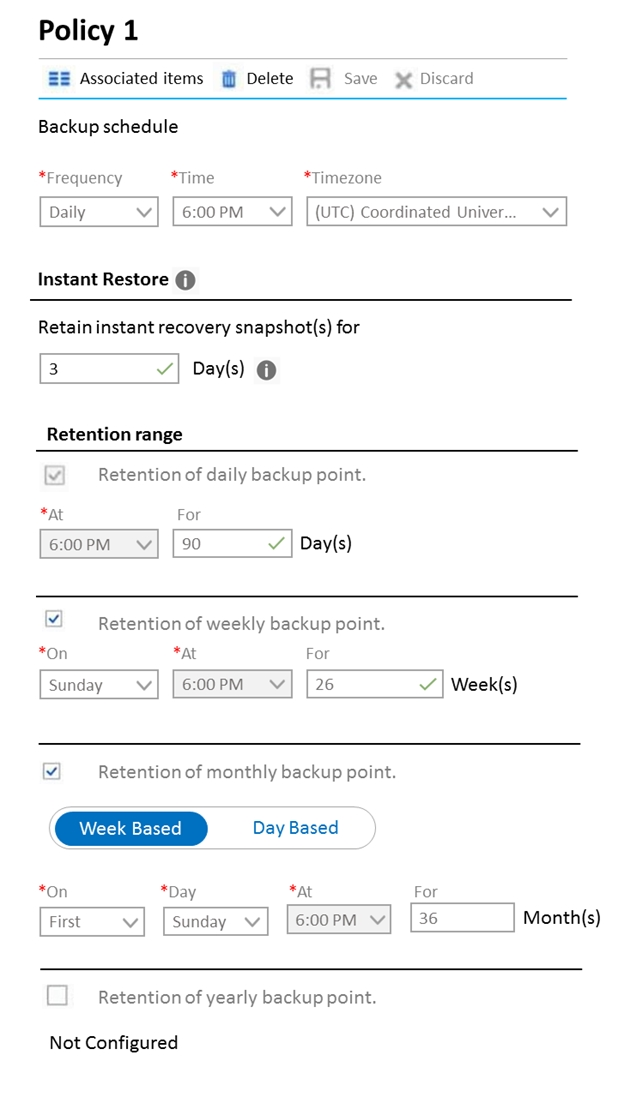
Use the drop-down menus to select the answer choice that completes each statement based on the information presented in the graphic.
NOTE: Each correct selection is worth one point.
Hot Area: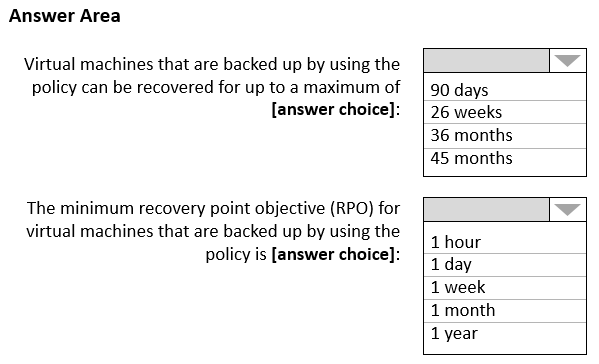
Answer:
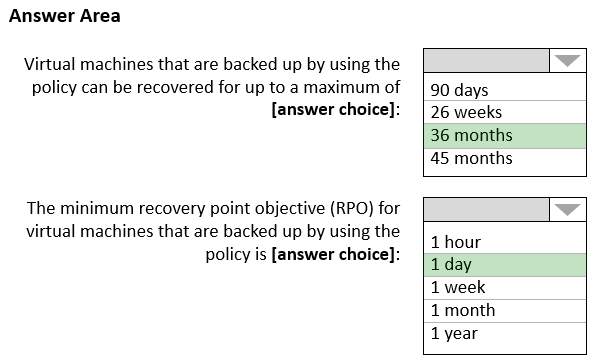
Note: This question is part of a series of questions that present the same scenario. Each question in the series contains a unique solution that might meet the stated goals. Some question sets might have more than one correct solution, while others might not have a correct solution.
After you answer a question in this section, you will NOT be able to return to it. As a result, these questions will not appear in the review screen.
You need to deploy resources to host a stateless web app in an Azure subscription. The solution must meet the following requirements:
✑ Provide access to the full .NET framework.
Provide redundancy if an Azure region fails.
✑ Grant administrators access to the operating system to install custom application dependencies.
Solution: You deploy two Azure virtual machines to two Azure regions, and you create an Azure Traffic Manager profile.
Does this meet the goal?
Answer:
A
Azure Traffic Manager is a DNS-based traffic load balancer that enables you to distribute traffic optimally to services across global Azure regions, while providing high availability and responsiveness.
Note: This question is part of a series of questions that present the same scenario. Each question in the series contains a unique solution that might meet the stated goals. Some question sets might have more than one correct solution, while others might not have a correct solution.
After you answer a question in this section, you will NOT be able to return to it. As a result, these questions will not appear in the review screen.
You need to deploy resources to host a stateless web app in an Azure subscription. The solution must meet the following requirements:
✑ Provide access to the full .NET framework.
✑ Provide redundancy if an Azure region fails.
✑ Grant administrators access to the operating system to install custom application dependencies.
Solution: You deploy two Azure virtual machines to two Azure regions, and you deploy an Azure Application Gateway.
Does this meet the goal?
Answer:
B
App Gateway will balance the traffic between VMs deployed in the same region. Create an Azure Traffic Manager profile instead.
HOTSPOT -
You have an on-premises file server that stores 2 TB of data files.
You plan to move the data files to Azure Blob Storage in the West Europe Azure region.
You need to recommend a storage account type to store the data files and a replication solution for the storage account. The solution must meet the following requirements:
✑ Be available if a single Azure datacenter fails.
✑ Support storage tiers.
✑ Minimize cost.
What should you recommend? To answer, select the appropriate options in the answer area.
NOTE: Each correct selection is worth one point.
Hot Area: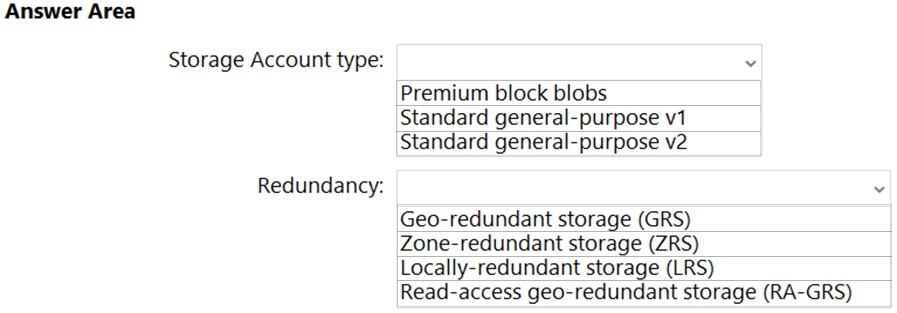
Answer:
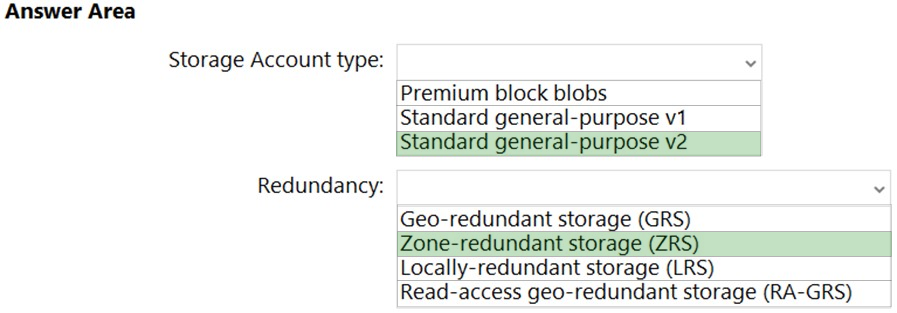
Box 1: Standard general-purpose v2
Standard general-purpose v2 meets the requirements and minimizes the costs.
Box 2: Zone-redundant storage (ZRS)
ZRS protects against a Datacenter failure, while minimizing the costs.
Reference:
https://docs.microsoft.com/en-us/azure/storage/common/storage-redundancy
HOTSPOT -
You have an Azure web app named App1 and an Azure key vault named KV1.
App1 stores database connection strings in KV1.
App1 performs the following types of requests to KV1:
✑ Get
✑ List
✑ Wrap
✑ Delete
Unwrap -
✑ Backup
✑ Decrypt
✑ Encrypt
You are evaluating the continuity of service for App1.
You need to identify the following if the Azure region that hosts KV1 becomes unavailable:
✑ To where will KV1 fail over?
✑ During the failover, which request type will be unavailable?
What should you identify? To answer, select the appropriate options in the answer area.
NOTE: Each correct selection is worth one point.
Hot Area: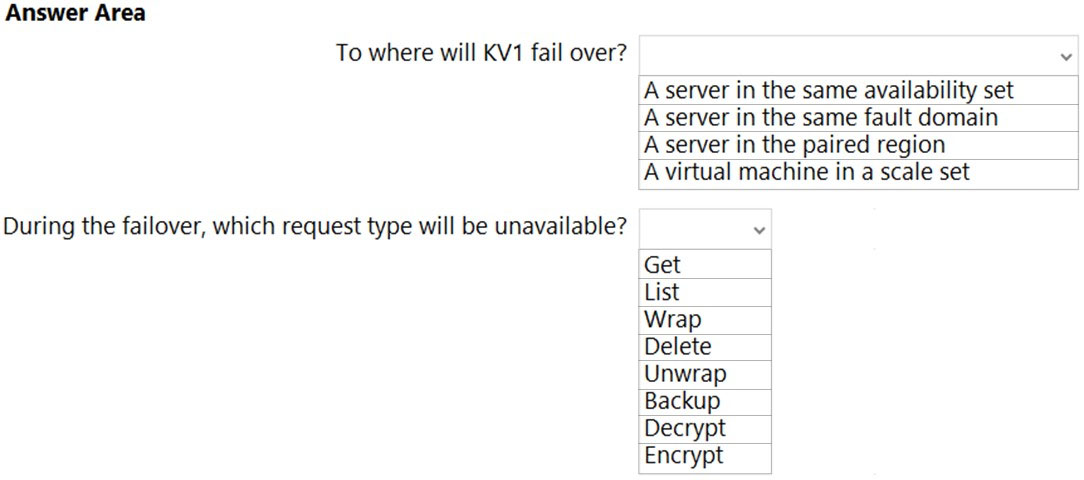
Answer:
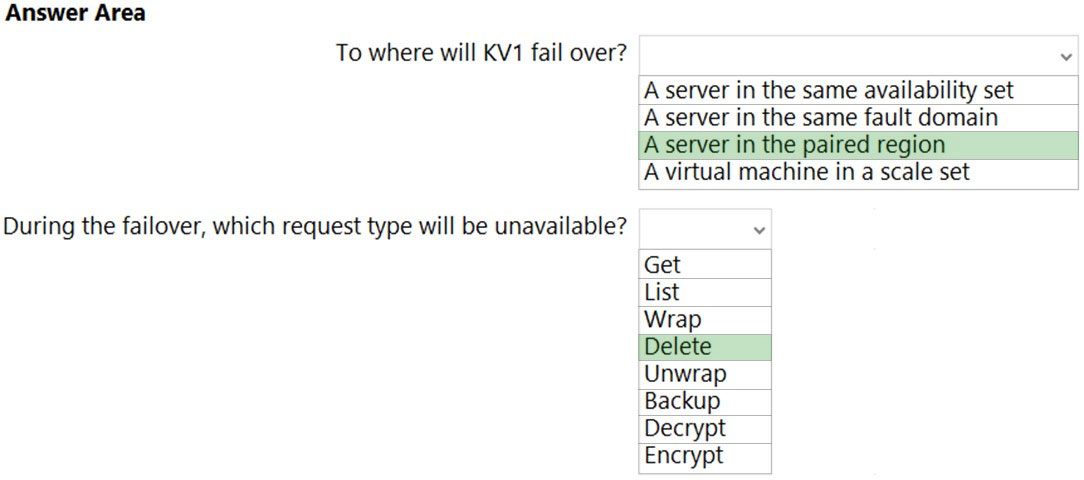
Box 1: A server in the paired region
The contents of your key vault are replicated within the region and to a secondary region at least 150 miles away, but within the same geography to maintain high durability of your keys and secrets.
Regions are paired for cross-region replication based on proximity and other factors.
Box 2: Delete -
During failover, your key vault is in read-only mode. Requests that are supported in this mode are:
List certificates -
Get certificates -
List secrets -
Get secrets -
List keys -
Get (properties of) keys -
Encrypt -
Decrypt -
Wrap -
Unwrap -
Verify -
Sign -
Backup -
Reference:
https://docs.microsoft.com/en-us/azure/key-vault/general/disaster-recovery-guidance
DRAG DROP -
Your company identifies the following business continuity and disaster recovery objectives for virtual machines that host sales, finance, and reporting applications in the company's on-premises data center:
✑ The sales application must be able to fail over to a second on-premises data center.
✑ The reporting application must be able to recover point-in-time data at a daily granularity. The RTO is eight hours.
✑ The finance application requires that data be retained for seven years. In the event of a disaster, the application must be able to run from Azure. The recovery time objective (RTO) is 10 minutes.
You need to recommend which services meet the business continuity and disaster recovery objectives. The solution must minimize costs.
What should you recommend for each application? To answer, drag the appropriate services to the correct applications. Each service may be used once, more than once, or not at all. You may need to drag the split bar between panes or scroll to view content.
NOTE: Each correct selection is worth one point.
Select and Place:
Answer:

Box 1: Azure Site Recovery -
Azure Site Recovery -
Coordinates virtual-machine and physical-server replication, failover, and fullback.
DR solutions have low Recovery point objectives; DR copy can be behind by a few seconds/minutes.
DR needs only operational recovery data, which can take hours to a day. Using DR data for long-term retention is not recommended because of the fine-grained data capture.
Disaster recovery solutions have smaller Recovery time objectives because they are more in sync with the source.
Remote monitor the health of machines and create customizable recovery plans.
Box 2: Azure Site Recovery and Azure Backup
Backup ensures that your data is safe and recoverable while Site Recovery keeps your workloads available when/if an outage occurs.
Box 3: Azure Backup only -
Azure Backup -
Backs up data on-premises and in the cloud
Have wide variability in their acceptable Recovery point objective. VM backups usually one day while database backups as low as 15 minutes.
Backup data is typically retained for 30 days or less. From a compliance view, data may need to be saved for years. Backup data is ideal for archiving in such instances.
Because of a larger Recovery point objective, the amount of data a backup solution needs to process is usually much higher, which leads to a longer Recovery time objective.
Reference:
https://lighthousemsp.com/whats-the-difference-between-azure-backup-and-azure-site-recovery/
You need to design a highly available Azure SQL database that meets the following requirements:
✑ Failover between replicas of the database must occur without any data loss.
✑ The database must remain available in the event of a zone outage.
✑ Costs must be minimized.
Which deployment option should you use?
Answer:
D
General Purpose service tier provides zone redundant availability.
There are two high availability architectural models:
* Standard availability model that is based on a separation of compute and storage. It relies on high availability and reliability of the remote storage tier. This architecture targets budget-oriented business applications that can tolerate some performance degradation during maintenance activities.
* Premium availability model that is based on a cluster of database engine processes. It relies on the fact that there is always a quorum of available database engine nodes. This architecture targets mission-critical applications with high IO performance, high transaction rate and guarantees minimal performance impact to your workload during maintenance activities.
Note: Zone-redundant configuration for the general purpose service tier is offered for both serverless and provisioned compute. This configuration utilizes Azure
Availability Zones ג€‰to replicate databases across multiple physical locations within an Azure region.ג€‰By selecting zone-redundancy, you can make yourג€‰new and existing serverless and provisioned generalג€‰purpose single databases and elastic pools resilient to a much larger set of failures, including catastrophic datacenter outages, without any changes of the application logic.
Incorrect:
Not A: Azure SQL Managed Instance Business Critical is more expensive.
Not B: Premium is more expensive.
Not C: Azure SQL Database Basic, and General purpose provide only locally redundant availability.
Reference:
https://docs.microsoft.com/en-us/azure/azure-sql/database/high-availability-sla
You need to design a highly available Azure SQL database that meets the following requirements:
✑ Failover between replicas of the database must occur without any data loss.
✑ The database must remain available in the event of a zone outage.
✑ Costs must be minimized.
Which deployment option should you use?
Answer:
B
Azure SQL Database Premium meets the requirements and is the least expensive.
Note: There are two high availability architectural models:
* Standard availability model that is based on a separation of compute and storage. It relies on high availability and reliability of the remote storage tier. This architecture targets budget-oriented business applications that can tolerate some performance degradation during maintenance activities.
* Premium availability model that is based on a cluster of database engine processes. It relies on the fact that there is always a quorum of available database engine nodes. This architecture targets mission-critical applications with high IO performance, high transaction rate and guarantees minimal performance impact to your workload during maintenance activities.
Note: Zone-redundant configuration for the general purpose service tier is offered for both serverless and provisioned compute. This configuration utilizes Azure
Availability Zones ג€‰to replicate databases across multiple physical locations within an Azure region.ג€‰By selecting zone-redundancy, you can make yourג€‰new and existing serverless and provisioned generalג€‰purpose single databases and elastic pools resilient to a much larger set of failures, including catastrophic datacenter outages, without any changes of the application logic.
Incorrect:
Not A: Azure SQL Managed Instance Business Critical is more expensive.
Not C: Azure SQL Database Basic, and General purpose provide only locally redundant availability.
Reference:
https://docs.microsoft.com/en-us/azure/azure-sql/database/high-availability-sla